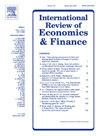Exploration on the impact of low carbon pilot policies on rural industrial development under the background of “Dual-carbon” goals
IF 5.6
2区 经济学
Q1 BUSINESS, FINANCE
引用次数: 0
Abstract
Initiated in 2010 and implemented in three batches across selected provinces and cities, the low-carbon policy is a pivotal initiative in China dedicated to actualizing the “Dual-carbon” goal by cutting down upon greenhouse gas emissions, lessening industrial carbon output, and pushing ahead low-carbon development in urban and rural economies. This study explores how these strategies affect the efficiency of rural industrial development in pilot areas, which is directly correlated with rural revitalization and common prosperity. It puts forward several hypotheses with regard to the association between low-carbon pilot policies and TFP in rural industries, using panel data from 1674 county-level cities in China from 2001 to 2022. Although effects vary spatially on account of geographical and economic factors, the research deems that these policies noticeably enhance overall rural industry TFP, which can be validated when we treat low-carbon pilot policies as a quasi-natural experiment and employing a multi-period double difference method. The policies have a notable and positive impact in regions south of the Qinling Huaihe River, east of the Hu Huanyong line, and in resource-based western areas, highlighting the synergy between policy adaptability and regional endowments. Mechanism analysis reveals that inter-provincial policy collaboration enhances effectiveness through a “provincial-prefecture level” governance mechanism, which underscores the importance of multi-level policy linkage for improving rural green transformation efficiency. Nonetheless, the influence of low-carbon agricultural initiatives and carbon peak measures—both as structural components within certain regional low-carbon pilot policy implementations—demonstrates temporal variability, with the latter showing short-term inhistory effects on rural industry TFP, highlighting tensions between strict carbon constraints and rural economic growth objectives.
“双碳”目标背景下低碳试点政策对农村产业发展的影响探讨
低碳政策于2010年启动,在选定的省市分三批实施,是中国通过减少温室气体排放、减少工业碳排放、推动城乡经济低碳发展,实现“双碳”目标的关键举措。本研究探讨这些策略如何影响试点地区乡村产业发展效率,这直接关系到乡村振兴与共同富裕。本文利用2001 - 2022年中国1674个县级市的面板数据,对低碳试点政策与农村工业全要素生产率之间的关系提出了若干假设。尽管受地理和经济因素的影响,这些政策的效果在空间上存在差异,但研究认为,这些政策显著提高了农村工业的整体TFP,这可以通过将低碳试点政策作为准自然实验,采用多期双差方法来验证。政策对秦岭淮河以南、胡焕庸线以东、西部资源型地区的正向影响显著,政策适应性与区域禀赋的协同效应显著。机制分析表明,省际政策协同通过“省地级”治理机制提升效能,凸显了多层次政策联动对提高农村绿色转型效率的重要性。尽管如此,低碳农业倡议和碳峰值措施的影响——两者都是某些区域低碳试点政策实施中的结构性组成部分——表现出时间变异性,后者对农村工业TFP表现出短期的历史影响,突出了严格的碳约束与农村经济增长目标之间的紧张关系。
本文章由计算机程序翻译,如有差异,请以英文原文为准。
求助全文
约1分钟内获得全文
求助全文
来源期刊
CiteScore
7.30
自引率
2.20%
发文量
253
期刊介绍:
The International Review of Economics & Finance (IREF) is a scholarly journal devoted to the publication of high quality theoretical and empirical articles in all areas of international economics, macroeconomics and financial economics. Contributions that facilitate the communications between the real and the financial sectors of the economy are of particular interest.

 求助内容:
求助内容: 应助结果提醒方式:
应助结果提醒方式:


